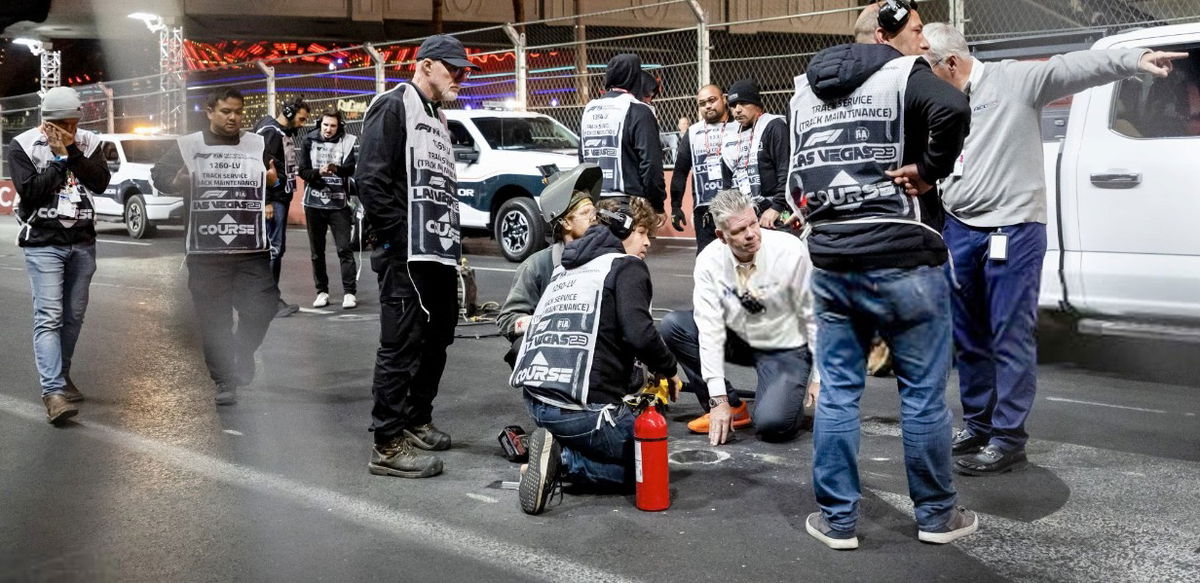

The much-awaited Las Vegas GP faced an unexpected hurdle right out of the gate. The opening practice session on the city’s new circuit was abruptly cut short, a mere eight minutes in, due to a loose drain cover that caused significant damage to Ferrari driver Carlos Sainz‘s car. This incident, seemingly small in nature, cascaded into a much larger problem, highlighting critical safety concerns on the track.
Watch What’s Trending Now!
Race Director Niels Wittich, with his keen eye for safety, had earlier expressed dissatisfaction with the track’s condition following an inspection on Tuesday. He requested another inspection post the opening ceremony, a move that now seems prescient given the events that unfolded. Wittich’s decision to halt the race was a clear indication of the seriousness of the situation.
ADVERTISEMENT
What went wrong at the Las Vegas GP FP1?
The FIA (Federation Internationale de l’Automobile) subsequently issued a statement, acknowledging the failure of the concrete frame around the manhole cover and the need to inspect all manhole covers on the track – a task that would take considerable time.
🚨 ¡OJO! La ceremonia de apertura del miércoles impidió a La FIA inspeccionar debidamente la pista antes de los Libres 1.
👉 La inspección del martes no dejó conforme a Niels Wittich, director de carrera, y pidió hacer otra después de la ceremonia. Hasta ahí no estaba… pic.twitter.com/qQajWcCC2A
— Fórmula Directa (@FormulaDirecta) November 17, 2023
The incident has sparked varied reactions within the F1 community. Ferrari Team Principal Frederic Vasseur expressed his anger and frustration at the damage sustained by Sainz’s vehicle, describing it as “unacceptable” and highlighting the extensive and costly damage to the car, including to its monocoque, engine, and battery. In contrast, Mercedes Team Principal Toto Wolff offered a staunch defense of the Las Vegas GP organizers. He downplayed the incident, arguing that such issues are not uncommon in F1 and shouldn’t overshadow the overall event, emphasizing the need to focus on resolving the issue rather than labeling it a setback for the sport.
ADVERTISEMENT
This incident is not the first of its kind in F1 history. A similar situation occurred at the 2019 Azerbaijan Grand Prix, where George Russell’s Williams car was damaged by a loose manhole cover, leading to the cancellation of the first practice session. Given the race director’s pre-emption of this issue, things could have been checked & inspected in a better manner, as F1 hopes to make Vegas a memorable event.
Read More: Despite Mass Backlash by Residents, “Well-Versed” F1 Lauds Itself for Las Vegas GP Prep
ADVERTISEMENT
The Las Vegas GP, a significant event in the F1 calendar, was supposed to showcase the sport’s return to the city in a spectacular fashion. However, this mishap has instead brought to light the challenges of racing in urban environments, where the smallest oversight can lead to significant repercussions.
Las Vegas GP: Latest updates on the manhole-matter
The latest status of the Las Vegas GP, following the manhole cover incident, is a blend of rapid response, ongoing assessments, and a palpable sense of urgency to ensure safety. The FIA, faced with a significant safety concern, may have to cancel the entire day’s practice sessions. This decision comes after Ferrari’s Carlos Sainz experienced “quite extensive” damage to his car.
ADVERTISEMENT
The FIA’s acknowledgment of the failure of a concrete frame around a manhole cover on the iconic Strip, where the incident occurred, underlines the severity of the situation. This necessitates a thorough inspection of all remaining drains along the 3.8-mile circuit, a task that is expected to be time-consuming. The need for discussions with the local engineering team indicates the complexity of the issue. Former F1 driver and Sky Sports pundit Martin Brundle speculated that the second practice session (FP2) might also be canceled, given the extensive nature of the repairs and safety checks needed.
Practice 2 is expected to commence at 2am local time in Las Vegas.
This is subject to local circuit engineering team completing the necessary works on the track.
The session will be extended to 90 minutes.#F1 #LasVegasGP
— Formula 1 (@F1) November 17, 2023
A joint statement from F1 and Las Vegas Grand Prix Inc. confirmed that they are actively working to resolve the issue. They promised to provide an update on the race schedule as soon as possible, highlighting their commitment to a quick and efficient resolution. Meanwhile, the FP2 session has been moved from 12 AM to 2 AM local time (5 AM ET) & extended to 90 minutes instead of the traditional 60 minutes.
ADVERTISEMENT
WATCH THIS STORY | When F1 Had 7 Different Winners in the First 7 Races of the Season
This situation underscores the challenges of hosting a Grand Prix in urban environments, where infrastructure elements like manhole covers can become unexpected hazards. The focus now shifts to ensuring that all safety measures are in place and effective, to prevent any recurrence of such incidents and to maintain the integrity of this high-profile event.
ADVERTISEMENT
ADVERTISEMENT
ADVERTISEMENT

